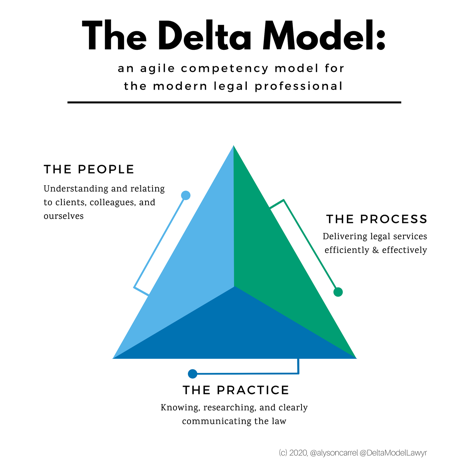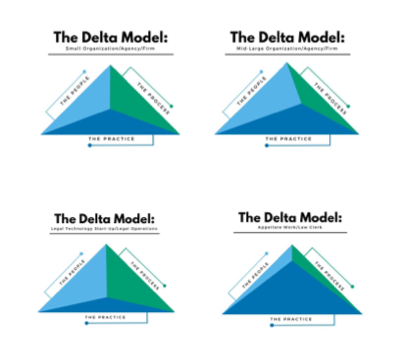In this moment, we need to reflect on what the global coronavirus pandemic and protests in the name of George Floyd, Breonna Taylor, and Ahmaud Arbery mean for our institutions and our students – who we teach, what we teach, and how we teach. The pipeline for admitting, training, and licensing legal professionals is broken. We need to consider if there are new competencies to add and new frameworks in which to add them. It doesn’t make sense to look back and long for a return to ‘normal’ when ‘normal’ wasn’t working. It shouldn’t be news to anyone, and probably isn’t to anyone reading this blog, that the legal profession was so bereft of technology competency that it was embarrassing. In the wake of COVID-19, lawyers, and courthouses, let alone law schools, struggled to move online. And it is even more embarrassing that decades of efforts to increase diversity in our law schools and our profession have yielded so little progress. Yes, there has been some improvement, but when law students and associates tell us that they do not feel welcome, heard, understood, or cared about, we know we haven’t done enough.
If we recognize this ‘normal’ wasn’t working, then we need something new to take its place. Enter the Delta Model. The Delta Model is an agile competency model for the 21st-century legal professional that reflects and visualizes a more holistic set of knowledge and skills. To be sure, this model and set of knowledge and skills won’t address decades, if not centuries, of flaws overnight. However, it has the potential to help our profession recognize that legal professionals must broaden their skill set beyond “thinking like a lawyer,” as well as reimagine how students apply for law school, get hired, take the bar, and progress in their careers — without suffering from the structural racism currently baked into the system.
The Delta Model grew out of the notion of a T-shaped lawyer, a term coined in 2016 by Amani Smathers. The T-shaped lawyer recognizes that to succeed as an attorney, one must not only possess a strong understanding of the law and legal skills, but must also have an awareness of complementary and related fields such as project management, data analytics, and technology. Ms. Smathers introduced this concept as the legal profession struggled to adapt to the growing role of technology in society. The Delta Model also recognizes skills related to the O-shaped lawyer. The O-shaped lawyer presents a “people first; then lawyers” approach, focusing on skills related to understanding and relating to our clients, our colleagues, and ourselves.
The Delta model uniquely presents a more holistic approach in the form of a triangle, each side representing three different competency areas necessary for success in the 21st century, including both the T-Shaped and O-Shaped skills as well as traditional notions of “thinking like a lawyer.” Cat Moon and I label the three sides as: The Practice, or the traditional competencies associated with lawyering such as legal knowledge, drafting, and advocacy; The Process, or those competencies related to the delivery of legal services such as project management, technology, and business fundamentals; The People, or those personal effectiveness skills needed to effectively work with others, empathize, and listen, in what is essentially a service industry.

With these three sides, the Delta Model creates a visualization that recognizes a need to increase technology competency in the face of COVID-19 and various work from home models. It also shines a spotlight on the human and relational aspect of lawyering that requires inclusivity, an understanding of bias, and empathy.
If law schools adopt the Delta Model as a framework from which to design curricular and co-curricular programming, the profession would develop greater competency in the specific areas that the pandemic and protests so starkly demonstrate are lacking.
But merely recognizing and expanding lawyers’ skill sets won’t address the structural racism and flaws. We need to take this moment as an opportunity to reimagine the profession entirely, redesigning the structure of the profession’s pipeline without the racism baked in. This notion of “reimagining” a system is not new either. Writers such as Roxane Gay and Michelle Alexander call on us to reimagine justice and law enforcement. And essayist Arundhati Roy calls on us to more broadly recognize this upheaval and disruption as an opportunity. She suggests that we “imagine another world” that is free from the constraints and impediments of the past.
“Our minds are still racing back and forth, longing for a return to “normality”, trying to stitch our future to our past and refusing to acknowledge the rupture. But the rupture exists. And in the midst of this terrible despair, it offers us a chance to rethink the doomsday machine we have built for ourselves. Nothing could be worse than a return to normality. Historically, pandemics have forced humans to break with the past and imagine their world anew. This one is no different. It is a portal, a gateway between one world and the next. We can choose to walk through it, dragging the carcasses of our prejudice and hatred, our avarice, our data banks and dead ideas, our dead rivers and smoky skies behind us. Or we can walk through lightly, with little luggage, ready to imagine another world. And ready to fight for it.”
-Arundhati Roy, Arundhati Roy: ‘The pandemic is a portal’
Therefore, we need to look at the Delta Model not only as a more holistic understanding of the skills legal professionals need in order to succeed in the 21st-century. We need to look at the Delta Model as a framework from which we can reimagine the profession’s pipeline. We’ve known for decades that the LSAT is a flawed predictor of success in the law. And research is now showing that the LSAT has a disparate impact on Black applicants, creating “steep disadvantages in gaining admission.” We need an anti-racist approach to reimagine the system without this disparate impact, instead of the way most current diversity efforts spend resources on mentorship and training as a means of overcoming these disadvantages. Why are there disadvantages in the first place?
In the 1990s, Marjory Schultz & Sheldon Zedeck’s research found that assessments based on situational judgments related to “problem-solving, practical judgment, listening, organizing and managing one’s own work, building and developing relationships (with clients, with other attorneys) and the ability to see the world through the eyes of others” not only predicted professional competence more accurately but also that the outcomes were race-neutral. Might a law school application that focuses on the more holistic competencies identified in the Delta Model remove the disadvantages and create the opportunity for more applicants, while at the same time predicting success in one’s career more accurately. Many law schools have begun moving away from relying solely on the LSAT and now allow applicants to utilize GRE scores as a means of assessment. Not only is the GRE accepted at a broader array of programs (including business school and other graduate programs), the exam is offered more frequently than the LSAT. Some schools have said they are accepting the GRE in an “effort to make law school more accessible to students from diverse backgrounds.” However, research has shown that the GRE similarly fails to predict success in one’s career and similarly has a disparate impact. Looking at these efforts, one can argue the desire to increase diversity in the profession’s pipeline exists, but the assessments are still flawed and the unfair disadvantages still exist. Former Dean of Northwestern Pritzker School of Law, Daniel Rodriguez, comments, “unless law schools fundamentally alter the manner in which they use admissions tests, adoption of the GRE will only preserve the unfortunate status quo as it relates to diversity. Applicants with lower scores will still be shut out of law school to extents that are unsupported by the predictive value of the tests, whether it’s the LSAT or the GRE.”
The LSAT and application processes are not the only problems. The pandemic is highlighting the many problems with the traditional bar exam as well. As states debate whether or not to hold the exam or grant graduates diploma privileges, many are questioning the value of this relic altogether. Not only are bar examiners struggling to move beyond the traditional in-person format of the exam, but researchers have also long pointed out that the skills taught in law school and tested in the bar exam do not equate with those associated in practice. From the Carnegie and MacCrate reports advocating for more focus on skills-based learning, to the more recent research from the Institute for the Advancement of the American Legal System (IAALS), Foundations for Practice report, demonstrating that attorneys expect a much broader skillset in recent graduates than “thinking like a lawyer,” it is clear that that there is a disconnect between legal education and practice. IAALS is now working with law schools and law firms to “develop and promote [an] understanding of the minimum competence needed to practice law; align the bar exam with research-based concepts of minimum competence.” Earlier this year, Professor Joan Howarth demonstrated how a Title VII analysis of the Bar Exam shows a disparate impact and wrongly testing one’s ability to study the law, not practice it. She identifies at least three alternatives, providing hope that licensing can result in more skilled attorneys and with less discriminatory impact: New Hampshire’s Daniel Webster Honors Program, Canada’s Practice Readiness Education Program, and NCBE’s Testing Task Force.
“If law schools would teach @DeltaModelLawyr skills, bar examiners would assess for them, and employers would hire for them, just imagine how holistically competent the legal profession would be!”
@inspiredcat, July 8, 2020
If these programs demonstrate how we can more accurately assess the actual skills needed to practice and do so without a discriminatory impact, why don’t we see more states adopt these changes? Change is hard. And the legal profession is notoriously bad at change. But it’s way past time to face the flaws of the profession and create something better. As Princeton’s Professor Eddie Gaud Jr stated, “COVID has changed everything, has changed everything. We can’t go back to what was. We can’t allow people to double down on their ugly commitments. We have to finally muster the courage to build a new America, or this thing will go to hell.”
I can’t in good conscience equate the state of America with the state of the legal profession, but the profession is certainly one of the many structures of this current state of America. And I hope that providing a new framework that is backed by original research, previous research (such as MacCrate and Carnegie reports), and contemporary research (such as IAALS Foundations of Practice and the ABA’s Principles for Legal Education and Licensure in the 21st-Century), regularly cited as calls to action, will provide enough precedent to stabilize this reimagining of legal education and the legal profession pipeline. The Delta Model in and of itself isn’t novel or new, but it provides a framework for understanding decades of research demonstrating a need to revamp legal education and presents that research in a simple visual that can be used in a myriad of ways. Below is a high-level outline of how the Delta Model could be used to reimagine the entirety of the pipeline. I don’t pretend to argue that this is a perfect idea, but I do hope it sparks some interest and gets others to realize that with a framework grounded in research, we really can reimagine this broken system, “ready to imagine another world. And ready to fight for it.”
REIMAGINING the LEGAL PROFESSION PIPELINE
- Law School Application Process: Replace LSAT and create new law school application assessments based on Delta Model behaviors/skills backed by research to predict success in law.
- Legal Education:
- Law Schools strategize course curriculum initiatives based on the Delta Model, ensuring the course catalog includes a spectrum of classes that provide students an opportunity to gain skills in each of the three sides of the Delta Model.
- Law Students chart course selection tailored to the specific set of skills they need to grow in order to reach the appropriate mastery level for whichever career path they choose.
- Licensure:
- Practicing Attorneys: Replace the current bar exam structure with one that assesses the broader array of skills necessary to succeed in practice instead of solely relying on issue spotting, rule regurgitation, and analysis. These are important skills, to be sure, but aren’t the ONLY skills lawyers need to succeed.
- Allied Professionals: Place all legal professional career paths in the same model, recognizing they require the same skills but with differing depths of the degree of mastery.
- The Dynamic Delta Model shifts the midpoint of the Delta to present multiple different maps, each representing a different mastery level of skill required depending on the type of position one holds.
- This places all legal professional positions (practicing lawyers as well as limited legal technicians, legal solutions architects, legal engineers, and more) on the competency map.
- Hiring and Advancement: Design a competency-based metric that identifies the specific skills someone must demonstrate to successfully perform their job responsibilities. Each firm or organization can create a customized Delta Map highlighting the specific skills/knowledge/attitudes under each of the three competency areas that best match their culture and practice specialty. But hiring decisions and advancement will be based on skill as opposed to law school, grades, and “fitting in.”

Tags: Drafting Clause, Delta Model, Drafting

